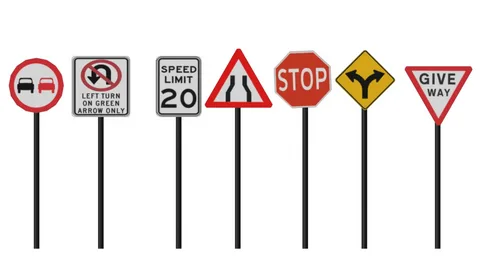Whether you’re driving across a rural highway or navigating a bustling city street, road signs guide your way. But have you ever wondered just how many road signs are there in the United States? With millions of miles of roads and countless intersections, it’s no surprise that the U.S. is home to an overwhelming number of traffic signs — from stop signs and speed limits to warning and regulatory signs.
In this article, we’ll explore the total number of traffic signs in the U.S., examine the types of signs and their functions, and take a look at interesting traffic sign statistics in the USA. We’ll also dive into the role of the Manual on Uniform Traffic Control Devices (MUTCD) in standardizing signage across the country.
Estimating the Total Number of Road Signs in the U.S.
While there’s no official, real-time database that tracks every road sign in America, transportation experts and civil engineers estimate there are approximately 40 million road signs in the United States.
This number is based on roughly 4.12 million miles of roadways in the country and an average of 10 to 12 signs per mile. That includes signs for speed limits, pedestrian crossings, stop signs, yield, construction zones, directional signs, and more.
Key Figures:
- Estimated total: 40 million signs
- Miles of roadways in the U.S.: 4.1+ million
- Average signs per mile: 10–12
These numbers may vary depending on the density of road networks in urban vs. rural areas. Heavily populated areas typically have a higher concentration of signs due to increased traffic volume and more complex intersections.
Types of Road Signs in the United States
To understand the scale of road signage, it’s helpful to look at the types of road signs in the United States. Signs fall into three primary categories:
1. Regulatory Signs
These tell drivers what they must or must not do under certain conditions.
- Examples: Stop signs, yield signs, speed limits, no parking
2. Warning Signs
These provide alerts about potential hazards or changes in road conditions.
- Examples: Curve ahead, school zones, pedestrian crossings, animal crossings
3. Guide and Informational Signs
These help navigate, providing information on directions, distances, services, and points of interest.
- Examples: Highway exit signs, rest area notifications, gas station symbols
Understanding the road sign categories used in the United States gives insight into just how extensive and standardized signage needs to be across different terrains and road types.
The Role of MUTCD in Signage
The Manual on Uniform Traffic Control Devices (MUTCD) is the federal standard for road signs in the U.S. It lists over 500 approved traffic signs and specifies their design, placement, color, and size.
What the MUTCD Covers:
- Fonts and symbols
- Reflectivity and visibility standards
- Mounting height and placement
Every public road — and many private roads — must follow MUTCD guidelines. That means everything from a simple stop sign to a complex directional highway sign must meet strict federal requirements.
Importance of MUTCD:
- Ensures consistency nationwide
- Enhances road safety
- Reduces driver confusion
How Many Stop Signs Are in the U.S.?
While the total number of stop signs in the U.S. isn’t officially published, they are among the most commonly used signs.
Estimated Figure:
- Based on traffic engineering surveys, it’s estimated that stop signs make up approximately 10% of all traffic signs, or 4 million stop signs nationwide.
These signs are especially prevalent in residential neighborhoods, intersections without traffic signals, and school zones.
Traffic Sign Statistics USA: By the Numbers
Here are some key figures to paint a clearer picture of the scope of traffic signs statistics in the USA:
| Metric | Estimated Value |
| Total road signs | 40 million+ |
| Regulatory signs (approx.) | 15–20 million |
| Warning signs | 10–15 million |
| Informational/Guide signs | 5–10 million |
| Signs installed annually | 2–3 million |
| MUTCD-approved sign types | 500+ |
US Road Signage Facts and Numbers
1. Materials and Lifespan
- Most signs are made of aluminum with reflective sheeting.
- Average lifespan: 7–10 years depending on climate and exposure.
2. Cost of a Typical Sign
- Basic regulatory signs (like stop or speed limit): $75–150
- Installation can add another $150–300 depending on labor and hardware.
3. Municipal Sign Inventories
- Cities like Los Angeles and New York maintain inventories with over 1 million road signs each.
- Smaller municipalities often manage 10,000 to 50,000 signs.
Why Accurate Signage Matters
It’s not just about numbers. The presence of clear and consistent signage is critical for public safety, especially with increasing traffic and urban growth.
Benefits:
- Prevents accidents
- Enhances traffic flow
- Supports pedestrian and cyclist safety
- Aids navigation for local and out-of-town drivers
As autonomous vehicles and smart transportation systems grow, maintaining a standardized, visible, and well-placed signage system becomes even more essential.
Challenges in Managing Signage
Even with clear guidelines, managing millions of road signs poses significant challenges:
- Aging infrastructure: Replacing faded or damaged signs
- Budget constraints: Municipalities must balance cost with compliance
- Vandalism and theft: Especially with popular signs like stop or street names
- Technological integration: Upgrading signs for digital and smart-road compatibility
Final Thoughts
So, how many road signs are there in the United States? While it’s impossible to count every single one, the consensus lands around 40 million signs and growing. Each sign — from a small no-parking marker to a massive highway exit display — plays a part in keeping our roads safe, efficient, and navigable.
Understanding the types, standards, and statistics behind road signage not only informs infrastructure planning but also emphasizes just how much goes into building a safe transportation system. As cities grow and vehicles evolve, keeping up with road sign standards is more important than ever.



